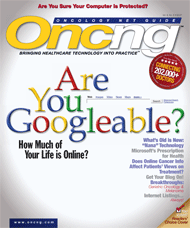Publication
Article
5 Questions with... Steve Shihadeh, GM of Microsoft Healthcare Industry Solutions Group
The beat on the people, devices, and companies shaping healthcare.
1 Why is Microsoft becoming more involved in the healthcare industry?
Microsoft has been in the healthcare industry for years, providing products like Windows and Office to hospitals, health plans, and other players and technology partners. All the major vendors that provide health-specific software to the healthcare industry use some sort of Microsoft technology. Because of this, we have been ranked by some companies as the number-eight player in healthcare IT. In early 2006, we formed the Health Solutions Group, with the express intent of figuring out how to address what we see as some pretty significant gaps in the healthcare market. Last August, Microsoft purchased the Azyxxi application [more on this below], which is what we refer to as a unified health enterprise platform. We think it addresses one of healthcare’s biggest enterprise issues, and that is “how do healthcare providers—who put a lot of money in technology investments—get access to all the information in those
systems, for the benefi t of the clinicians and ultimately for the benefi t of the organization?” The bigger health systems
have made large investments over the years in IT, and most of them really don’t have all that data integrated.
We also see an important need for someone to step up and help address healthcare from the consumer’s perspective. In February, we acquired a company called Medstory. If you go to Google and type in “earache” as one word, the first result is for a heavy metal rock band. That’s how most search engines work; whoever has the most hits is what flows to the top. If you’re a parent with a kid with an earache, that’s not what you want. You want a vertically relevant search. With Medstory.com, if you type in “earache” as one word, you get back information that would help you to get some answers and perhaps some opportunities to solve your earache problem.
2 What is it about the Azyxxi software that was so appealing to Microsoft, and how will it benefit hospitals and healthcare organizations?
One of the things that we love about that investment was that Azyxxi is really innovative technology built by physicians to solve a key critical information need that hospitals have: “How can they see all the data in one place about a patient?” On March 19, 2007, New York Presbyterian Health System became our first customer since Microsoft acquired Azyxxi. New York Presbyterian is a perfect example of the type of health system that will see a real benefit from Azyxxi. Like a lot of health systems, they have invested in applications—like CPOE (computerized physician order entry system), clinical systems, laboratory systems, radiology systems, imaging systems—yet they still aren’t able to leverage the investments and pull it all
together without tremendous expense. With Azyxxi, they will now have a single place in their information network to see every single piece of information about a patient.
3 What will Microsoft’s acquisition of Medstory mean for consumers?
We have a fair amount of experience working with consumers, and we tend to look at opportunities and problems from a consumer’s perspective. When we looked at the healthcare market, one of the first conclusions we came to was that health consumers frequently start their encounter with the health system through an online search for information. Medstory’s innovative search technology coupled with Microsoft’s marketing connection with consumers will allow us to provide powerful information a few clicks away to help somebody with a health concern, which is a great way to build a relationship with a consumer.
4 What is the Connected Health Framework Architecture and Design Blueprint?
The Connected Health Framework is a perfect example of Microsoft taking the leadership position in the healthcare space. It is available for free. It is basically a road map that health organizations can follow using a services-oriented
architecture (SOA) approach to implement connected systems. It’s not just about Microsoft; the service allows hospitals to use other companies’ technology. We’re sharing this blueprint in hopes of helping the industry get more connected, because we see connectedness as an essential component of providing for safety in medicine and better clinical outcomes. Since the Framework was announced at the Healthcare Information and Management Systems Society (HIMSS) conference in late February, we’ve had more than 20,000 free downloads.
5 Is there anything you’d like to add?
When Microsoft was founded 30 years ago, information for the most part was locked up in datacenters, and the consumer of that data really didn’t have much of a say about it. Microsoft has helped change that paradigm. Today, information is generally available in a secure and unlocked form for the consumer to benefi t from. We think that the healthcare market really has that same sort of old paradigm today—lots of data locked up in individual stores, and
it’s not all tied together for the benefit of consumers. We think it should be. We think that will change, and we’re trying to play a lead role in driving that change.
The Azyxxi homepage describes the technology as “a unified health enterprise platform that aggregates and enables analysis of all relevant data, from across an organization’s existing systems, for one, nearly instantaneous view.” Microsoft claims that “customized and timely access to data that spans clinical, financial, and administrative systems enables healthcare workers to maximize the value of information and make the most informed decisions.”
